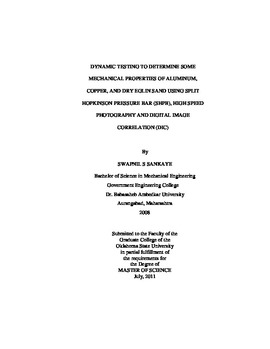| dc.contributor.advisor | Komanduri, Ranga | |
| dc.contributor.author | Sankaye, Swapnil S. | |
| dc.date.accessioned | 2014-04-17T19:54:00Z | |
| dc.date.available | 2014-04-17T19:54:00Z | |
| dc.date.issued | 2011-07-01 | |
| dc.identifier.uri | https://hdl.handle.net/11244/10054 | |
| dc.description.abstract | The compressive response or the dynamic mechanical behavior of aluminum, copper, and dry Eglin sand coupled with high-speed photography and Digital Image Correlation (DIC) analysis was investigated. Variables for the sand samples include the specimen initial mass density, particle size, and pulse shapers used at approximately constant strain rates and pressure applied. A modified SHPB has been used employing a pulse shaping technique to produce controlled dynamic load pulses that allows the specimen to deform uniformly under dynamic equilibrium conditions at constant strain rate. During each dynamic test the stress equilibrium conditions are maintained. The pulse-shaping technique was found to be independent of the confinement. The deformation and dynamic mechanical behavior of annealed copper sample were observed using a high speed digital camera. DIC technique was used to determine the surface strains through a series of images acquired using high speed photography. The absolute uniform axial strain obtained from DIC analysis was ∼18%, compared to strain gage analysis of ~19% axial strain. Dynamic compressive behavior of dry Eglin sand (received from Air Force Base (AFB) Florida), under confinement was characterized using an advanced long split Hopkinson pressure bar (SHPB). Sand grains were confined inside a hollow cylinder of hardened steel and capped by cemented tungsten carbide cylindrical rods. This assembly was subjected to repeated shaking to consolidate sand to reach given bulk mass densities. It is then sandwiched between the incident and transmission bars on SHPB for dynamic compression measurements. Sand specimens of three initial mass densities, namely, 1.51, 1.57, and 1.63 g/cm3, were characterized to determine the mechanical properties at high strain rates near 700 s- 1. The compressive mechanical response of fine sand was experimentally investigated. The initial mass density, pulse shapers, and particle size are systematically varied. The results show that the compressive response of the fine sand is not sensitive to strain rate under the loading conditions used in this study but significantly dependent on the initial mass density and grain size used in the confinement. The sand becomes stiffer as initial mass density increases and/or finer sand grain sizes are used. | |
| dc.format | application/pdf | |
| dc.language | en_US | |
| dc.publisher | Oklahoma State University | |
| dc.rights | Copyright is held by the author who has granted the Oklahoma State University Library the non-exclusive right to share this material in its institutional repository. Contact Digital Library Services at lib-dls@okstate.edu or 405-744-9161 for the permission policy on the use, reproduction or distribution of this material. | |
| dc.title | Dynamic Testing to Determine Some Mechanical Properties of Aluminum, Copper, and Dry Eglin Sand Using Split Hopkinson Pressure Bar (SHPB), High Speed Photography and Digital Image Correlation (DIC) | |
| dc.type | text | |
| dc.contributor.committeeMember | Harimkar, Sandip | |
| dc.contributor.committeeMember | Lucca, Don | |
| osu.filename | Sankaye_okstate_0664M_11522.pdf | |
| osu.college | Engineering, Architecture, and Technology | |
| osu.accesstype | Open Access | |
| dc.description.department | Mechanical & Aerospace Engineering | |
| dc.type.genre | Thesis | |
